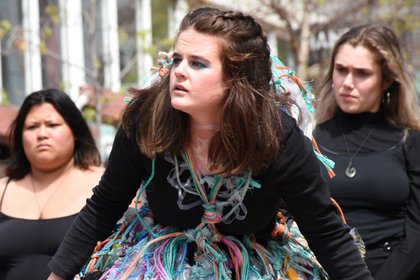
Graduate Kerris O’Donoghue performing in the course Creativity in the Community as part of Climate Change Theatre Action.
Teaching in Massey’s Expressive Arts programme in such courses as Creative Communication and Creativity in the Community, Associate Professor Elspeth Tilley found that it was often challenging to find resources on creative activism for her students.
“There are very few research-informed books on the ‘nuts and bolts’ of creative activism,” Dr Tilley says. “People were asking if I could recommend any good books on the topic. One of those people was Professor Leslie Carol Roberts from California College of the Arts, who was specifically looking for a diverse set of scholarly case studies and an overview of creative activism as a discipline. I said there wasn’t such a thing, and she said, ‘Well you better write one then’.”
That is how Creative Activism Research, Pedagogy and Practice, a collection of 29 chapters by 42 contributors, was born. Edited by Dr Tilley, with a foreword by Associate Professor of Social Science and Head of Global Studies at Roskilde University in Denmark, Silas Harrebye, this timely collection explores the growing global recognition of creativity and the arts as vital to social movements and change.

Associate Professor Elspeth Tilley.
About Creative Activism Research, Pedagogy and Practice
The book brings together diverse perspectives from leading academics and practitioners who investigate how creative activism is deployed, taught, and critically analysed.
Dr Tilley says she sent out a call for contributions in February 2020 and was staggered by the volume of responses. “More than a hundred expressions of interest arrived in my inbox within a few weeks, from all over the world. Creative activism is a global and thriving practice – the authors represent varied voices, including people of colour, indigenous authors, trans authors, disabled authors, and reflect diverse perspectives ranging from a full-time activist with Extinction Rebellion, to senior professors who are international arts and culture policy advisors."
The book’s five sections cover defining and theorising creative activism and key issues in the field; innovative modes and methods for teaching the next generation of creative activists; visual activism examples including art, photography, post-it-note walls, and digital tools; embodied creative activism through dance, flash mobs, and movement; and performative creative activism via theatre, performance art and puppetry.
The chapters span Europe, the Americas, Oceania, and Asia. The forms of activism examined are diverse, from aural installations, Shakespeare in prisons, and the pageantry of Extinction Rebellion, to digital scrapbooks, schools without walls, and printmaking. The issues tackled are similarly wide-ranging, including baby loss, rape culture, climate change, and the ethical problems with actor-training methodologies.
“I wanted the collection to include on-the-ground activists as well as academics who do activism as research, and to curate a book that would illuminate all the different and important contributions art and creativity can, and are, making to solving problems,” Dr Tilley says. “My own chapter in the book, the introduction, maps the historical and theoretical trajectories of creative activism’s evolution as a discipline, so it gives that ‘overview’ of where things have come from and the currents of thought (right back to Plato) that Professor Roberts and others were asking for.”
“I think the generosity of the authors in this volume has been amazing. Whether they are teaching creative activism in classrooms or practising it on the streets, the authors have been open, thorough, and clear about what works, what does not, and why. This can only help lift the bar and generate better understanding of how to deliver and enhance creative activism, as well as inspiring others as to what is possible.”
What is creative activism and why is it important
Creative activism is the wider label for the discipline of using art for understanding shared challenges and generating social justice, environmental awareness, and change.
“We know that our ‘old ways’ of thinking have got us into a mess, with climate change, war, and a toxic communicative environment in which people are polarised and shouting at each other without compassion or without the tools to build understanding,” Dr Tilley. “Art and creativity offer something different. Art is both a tool to facilitate innovation (new viewpoints, walking in others’ shoes, prototyping imaginary better worlds in literature or theatre), and a tool of connection (dancing, singing, writing or sculpting together creates bonds and an openness to dialogue, even between people whose views are very different)."
“When we are facing tough times economically, such as from a global pandemic, people tend to forget that art and creativity are key parts of the solution. Artistic tools are not better than other ways of solving problems, just different. Art adds something unique. Art and artists can be part of the solutions."
Book details
Dr Tilley says she wanted the book to be accessible to students, teachers, and practitioners of creative activism. “The e-book will be widely available from the same day as the hardback release so that lots of people (especially students) can read about creative activism.”
As well as Dr Tilley, there are four other Massey staff contributors to the book – Nicholas Holm, senior lecturer in Media Studies, Tracey Nicholls, who lectures in Politics and International Relations, Simone Gabriel, a lecturer in Content Development, and April-Rose Geers, a New Zealand poet and tutor in the School of Humanities, Media and Creative Communication.
Creative Activism Research, Pedagogy and Practice is published by Cambridge Scholars Publishing and is available here.